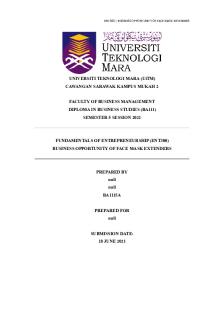Differential Opportunity Theory PDF

| Title | Differential Opportunity Theory |
|---|---|
| Course | Criminal Investigation |
| Institution | Community College of Baltimore County |
| Pages | 1 |
| File Size | 60.7 KB |
| File Type | |
| Total Downloads | 77 |
| Total Views | 150 |
Summary
Differential opportunity theory...
Description
Differential Opportunity Theory Richard Cloward and Lloyd Ohlin Differential Opportunity theory focuses on the discrepancy between what lower-class individuals (specifically juveniles) want and what is available to them. It assumes: People in all classes share the same success goals. People who consider themselves to be failures within conventional society will seek alternative ways to succeed. They then join a group of like-minded peers to form a gang that provides them emotional support. These gang members can earn a lot more money selling drugs or engaging in armed robberies than working at menial jobs. Differences occur between ability to achieve acceptable goals by legitimate means (Similar to Strain Theory) but there are also differential opportunities to use illegitimate means to reach those goals. The focus is on what juveniles want and what is available to them to achieve it. The further a person falls down the social ladder, the harder it is to achieve goals – both legally and illegally. Cloward and Ohlin describe two kinds of opportunities: Differences in learning structures – environment that nurtures and sustains pro-social behavior and attitudes Differences in access to performance structures – connection with peers who approve of their behavior Juveniles must learn skills and values and have support from their peers to sustain criminal behavior. The social structure of the community determines access to acquiring and participating in anti-social behavior. They identify three distinct types of delinquent subcultures that fit this need: 1. Criminal – develop in stable neighborhoods with close adolescent connections; youths are recruited into criminal gangs to provide training for successful criminal careers; skills necessary for successful offending are transmitted 2. Conflict – develop in unstable neighborhoods and attract tough adolescents; violence is used to protect turf, integrity, honor 3. Retreatist – double failures who use alcohol or drugs and commit crime to support this addiction; unable to attain success through legitimate or illegal means Access to success is also limited in these gangs so opportunities are unequal in both cultures – conventional and nonconventional. According to Cloward and Ohlin, criminal cultures can be supportive and profitable. This explains why people become involved in a particular type of criminal activity. It combines cultural deviance and social disorganization approaches.
Sources Glick, L. and Miller, J.M. (2008). Criminology (2nd ed.). Boston, MA: Pearson Education, Inc. Conklin, J. (2004). Criminology (8th ed.). Boston, MA: Pearson Education, Inc. Akers, R. and Sellers, C. (2009). Criminological Theories: Introduction, Evaluation and Application. (5th ed.). NY: Oxford University Press....
Similar Free PDFs

Differential Opportunity Theory
- 1 Pages

Business Opportunity
- 17 Pages

Business Opportunity
- 14 Pages

Product Opportunity Gap
- 8 Pages

ENT300 Business Opportunity report
- 13 Pages

Opportunity Analysis final final
- 12 Pages

Unequal Opportunity Race
- 3 Pages

Marketing Opportunity Bsbmkg 501
- 7 Pages

ENT300 - Business Opportunity
- 13 Pages

Differential reinforcement
- 4 Pages

Nike Blue Ocean Opportunity
- 4 Pages
Popular Institutions
- Tinajero National High School - Annex
- Politeknik Caltex Riau
- Yokohama City University
- SGT University
- University of Al-Qadisiyah
- Divine Word College of Vigan
- Techniek College Rotterdam
- Universidade de Santiago
- Universiti Teknologi MARA Cawangan Johor Kampus Pasir Gudang
- Poltekkes Kemenkes Yogyakarta
- Baguio City National High School
- Colegio san marcos
- preparatoria uno
- Centro de Bachillerato Tecnológico Industrial y de Servicios No. 107
- Dalian Maritime University
- Quang Trung Secondary School
- Colegio Tecnológico en Informática
- Corporación Regional de Educación Superior
- Grupo CEDVA
- Dar Al Uloom University
- Centro de Estudios Preuniversitarios de la Universidad Nacional de Ingeniería
- 上智大学
- Aakash International School, Nuna Majara
- San Felipe Neri Catholic School
- Kang Chiao International School - New Taipei City
- Misamis Occidental National High School
- Institución Educativa Escuela Normal Juan Ladrilleros
- Kolehiyo ng Pantukan
- Batanes State College
- Instituto Continental
- Sekolah Menengah Kejuruan Kesehatan Kaltara (Tarakan)
- Colegio de La Inmaculada Concepcion - Cebu




